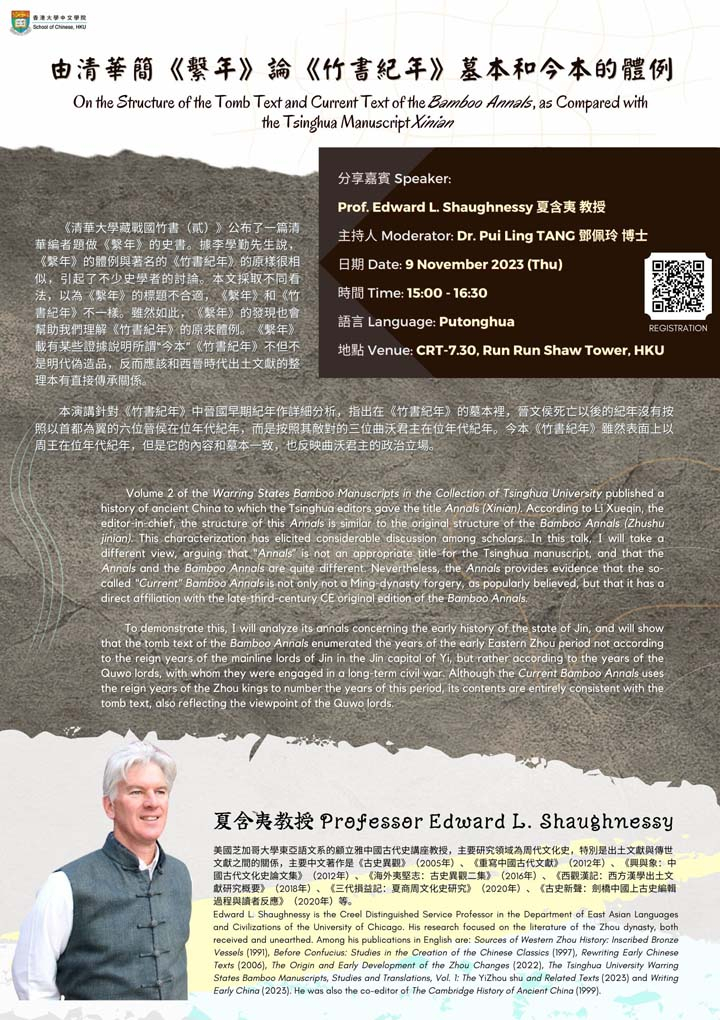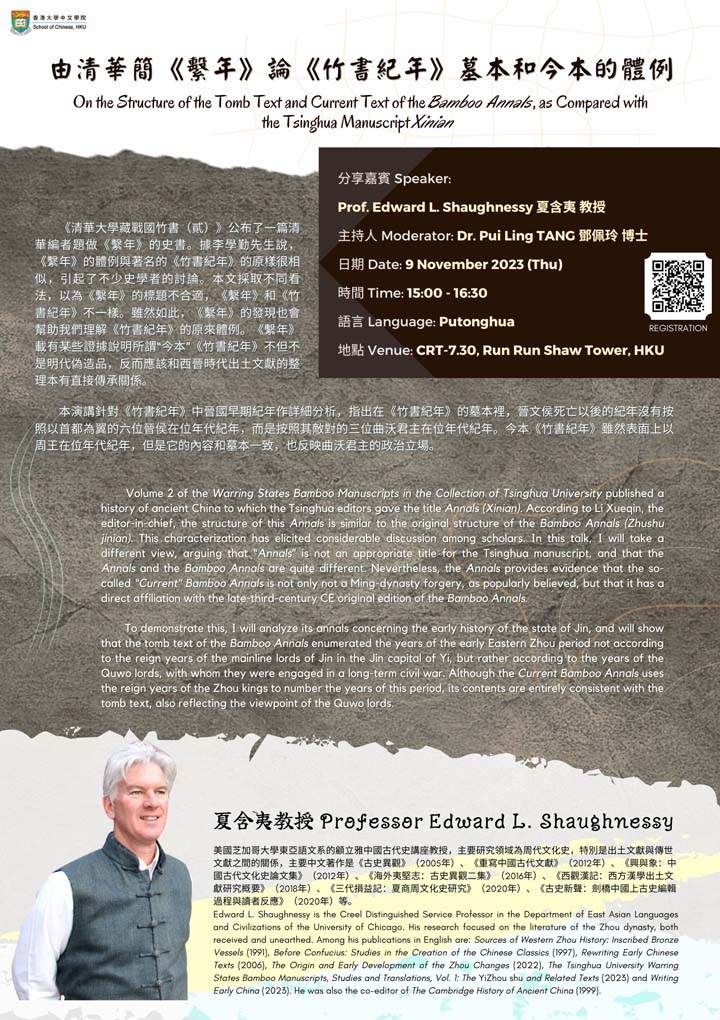由清華簡《繫年》論《竹書紀年》墓本和今本的體例 On the Structure of the Tomb Text and Current Text of the Bamboo Annals, as Compared with the Tsinghua Manuscript Xinian

School of Chinese Seminar
由清華簡《繫年》論《竹書紀年》墓本和今本的體例
On the Structure of the Tomb Text and Current Text of the Bamboo Annals, as Compared with the Tsinghua Manuscript Xinian
分享嘉賓 Speaker: Prof. Edward L. Shaughnessy 夏含夷教授
主持人 Moderator: Dr. Pui Ling TANG 鄧佩玲博士
日期 Date: 9 November 2023 (Thu)
時間 Time: 15:00 - 16:30
語言 Language: Putonghua
地點 Venue: CRT-7.30, Run Run Shaw Tower, HKU
《清華大學藏戰國竹書(貳)》公布了一篇清華編者題做《繫年》的史書。據李學勤先生說,《繫年》的體例與著名的《竹書紀年》的原樣很相似,引起了不少史學者的討論。本文採取不同看法,以為《繫年》的標題不合適,《繫年》和《竹書紀年》不一樣。雖然如此,《繫年》的發現也會幫助我們理解《竹書紀年》的原來體例。《繫年》載有某些證據說明所謂“今本”《竹書紀年》不但不是明代偽造品,反而應該和西晉時代出土文獻的整理本有直接傳承關係。
本演講針對《竹書紀年》中晉國早期紀年作詳細分析,指出在《竹書紀年》的墓本裡,晉文侯死亡以後的紀年沒有按照以首都為翼的六位晉侯在位年代紀年,而是按照其敵對的三位曲沃君主在位年代紀年。今本《竹書紀年》雖然表面上以周王在位年代紀年,但是它的內容和墓本一致,也反映曲沃君主的政治立場。
Volume 2 of the Warring States Bamboo Manuscripts in the Collection of Tsinghua University published a history of ancient China to which the Tsinghua editors gave the title Annals (Xinian). According to Li Xueqin, the editor-in-chief, the structure of this Annals is similar to the original structure of the Bamboo Annals (Zhushu jinian). This characterization has elicited considerable discussion among scholars. In this talk, I will take a different view, arguing that “Annals” is not an appropriate title for the Tsinghua manuscript, and that the Annalsand the Bamboo Annals are quite different. Nevertheless, the Annals provides evidence that the so-called “Current” Bamboo Annals is not only not a Ming-dynasty forgery, as popularly believed, but that it has a direct affiliation with the late-third-century CE original edition of the Bamboo Annals.
To demonstrate this, I will analyze its annals concerning the early history of the state of Jin, and will show that the tomb text of the Bamboo Annals enumerated the years of the early Eastern Zhou period not according to the reign years of the mainline lords of Jin in the Jin capital of Yi, but rather according to the years of the Quwo lords, with whom they were engaged in a long-term civil war. Although the Current Bamboo Annals uses the reign years of the Zhou kings to number the years of this period, its contents are entirely consistent with the tomb text, also reflecting the viewpoint of the Quwo lords.
夏含夷(Edward L. Shaughnessy)是美國芝加哥大學東亞語文系的顧立雅中國古代史講座教授,主要研究領域為周代文化史,特別是出土文獻與傳世文獻之間的關係,主要中文著作是《古史異觀》(2005年)、《重寫中國古代文獻》(2012年)、《興與象:中國古代文化史論文集》(2012年)、《海外夷堅志:古史異觀二集》(2016年)、《西觀漢記:西方漢學出土文獻研究概要》(2018年)、《三代損益記:夏商周文化史研究》(2020年)、《古史新聲:劍橋中國上古史編輯過程與讀者反應》(2020年)等。
Edward L. Shaughnessy is the Creel Distinguished Service Professor in the Department of East Asian Languages and Civilizations of the University of Chicago. His research focused on the literature of the Zhou dynasty, both received and unearthed. Among his publications in English are: Sources of Western Zhou History: Inscribed Bronze Vessels (1991), Before Confucius: Studies in the Creation of the Chinese Classics (1997), Rewriting Early Chinese Texts (2006), The Origin and Early Development of the Zhou Changes (2022), The Tsinghua University Warring States Bamboo Manuscripts, Studies and Translations, Vol. 1: The YiZhou shu and Related Texts (2023) and Writing Early China (2023). He was also the co-editor of The Cambridge History of Ancient China (199).
ALL are welcome
Registration: https://hku.au1.qualtrics.com/jfe/form/SV_esx5Ghrjq8tEMNE








